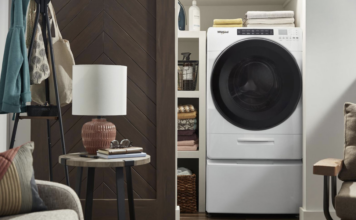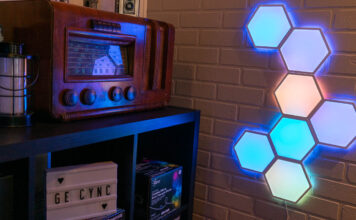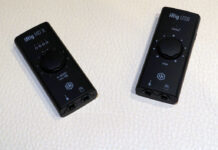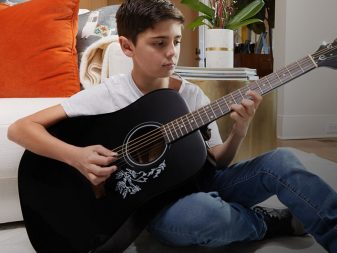 When I used to work in a music store, the most common question related to guitars was which one was the best choice for a child. With the amount of models available on the market, it’s not surprising that it was a recurring subject. At this point, it’s quite important to make the best decision possible. By picking the right guitar for your child, it will help maintain the interest for the instrument itself. I’ll be discussing the main types, sizes, and brands of guitars to help you make the ideal choice.
When I used to work in a music store, the most common question related to guitars was which one was the best choice for a child. With the amount of models available on the market, it’s not surprising that it was a recurring subject. At this point, it’s quite important to make the best decision possible. By picking the right guitar for your child, it will help maintain the interest for the instrument itself. I’ll be discussing the main types, sizes, and brands of guitars to help you make the ideal choice.
Type
Although they are built on the same basic principal, there are essentially three different categories of guitars: acoustic, nylon-stringed, and electric. They differ on how they project the sound, their shape, and their string material.
Acoustic
The acoustic guitar is a very widespread instrument. It’s very common in many different styles of music, and you probably have friends that have one at home. Many guitarists learned on one because it doesn’t require many accessories or amplification to be audible, and you can easily carry it with you anywhere you please. The strings are made of steel. This can be an unpleasant surface for beginners, especially if the neck falls out of adjustment and the distance between the strings and fretboard increases.
This is an important point for younger players, and if your child is susceptible to this type of pain, it’s probably best to avoid acoustics for now. They will eventually adapt and feel at home no matter the string material.
Nylon Stringed or Classical
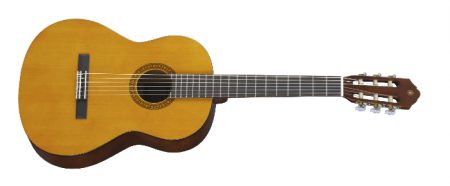 Although it’s a lot less common than its siblings, the nylon stringed guitar is a very popular choice as a first guitar for youngsters. The soft nylon strings provide an inviting experience. This offers a great starting point, since you won’t be distracted by any discomfort or pain.
Although it’s a lot less common than its siblings, the nylon stringed guitar is a very popular choice as a first guitar for youngsters. The soft nylon strings provide an inviting experience. This offers a great starting point, since you won’t be distracted by any discomfort or pain.
There’s not a lot of popular music that’s written with the classical in mind, but you can still strum along to your favourite artists. A lot of people go with this type of guitar for their children.
Electric Guitar
If you happen to have a kid that’s musically inclined and who knows what they want, they might nudge you towards the electric guitar. This was my case in my early teens. You’ll need a few extra accessories though, so keep that in mind. For example, you’ll need an amplifier and a cable to clearly hear what you are playing.
It’s not necessarily right for everyone. It has steel strings, so, again, you might hear some complaints. That being said, if your child has an interest for electrics, it’s definitely the way to go. The amount of time they pour into it will surprise you.
Size
To accommodate children, manufacturers offer smaller sized instruments. These have the same proportions, but are a lot easier to handle and to fret. They come in three different variations. First of all, the ¼ guitar is the smallest and will offer a comfortable playing experience to the youngest of players. The ½ is another option that’s available to cover the gap between the very young players and the pre-teens. Lastly, the ¾ is quite popular because it’s the closest to full size, while offering a bit more playability. A lot of people even go for this option, if it’s still a bit too big for their child, to maximize the mileage they get out of it.
Brand
I recommend going with recognizable brands. You’ll find many bargain priced products from little-known manufacturers. In my experience, under a hundred dollars you’ll get an instrument that’s hard to keep in tune and that might have some structural issues.

Companies that have great starter models include Yamaha, Fender (Squier), and Gibson (Epiphone). These big operations offer great quality control and a great overall value for your money.
Suggestions for picking out the right model
First of all, you’ll have to pick the appropriate type of guitar for your child. Unless you’ve noticed a musical preference, it’s safe to say that the classical guitar is the most logical choice. Mitigating finger fatigue and discomfort is a good way of keeping the interest up and will surely increase the overall pleasure at first.
However, it’s not wrong to start on an acoustic or electric. Older kids might already know what they want, and it’s a good idea to follow their interests. They might be itching to rock out, or maybe even accompany themselves while they sing their favourite songs. Some youngsters even gravitate towards blues music! For example, once I got my electric guitar, I was hooked and practiced constantly. I was very motivated to learn my favourite music, and the fire hasn’t gone away since that day—over 15 years ago.
For size, it’s a good thing to have your child hold it in a playing position. You’ll be able to visually determine how easy it is to grab the neck and move around the strings. Try to get them to press down on the strings on adjacent frets, and see if they can cover 4 different frets without too much of stretch. As a general rule, anyone 6 and under should probably use ¼ guitars, 6 to 9 year olds: ½ models, and 9 to 12: ¾ instruments. This obviously varies with individual growth, and it is common to make a conscious decision to go with a slightly bigger guitar to stretch out its service life.
 Finally, Yamaha has some excellent choices for beginners. It’s for that reason that you’ll find their guitars in schools around the world. For example, the C40 and C40S are very popular choices to start with, thanks to great construction and value. The company even offers a crossover between guitar and ukulele in the Guitalele. For more choices, check out BeaverCreek. They have many different models of various sizes. They even offer left-handed options to make sure everyone can learn guitar.
Finally, Yamaha has some excellent choices for beginners. It’s for that reason that you’ll find their guitars in schools around the world. For example, the C40 and C40S are very popular choices to start with, thanks to great construction and value. The company even offers a crossover between guitar and ukulele in the Guitalele. For more choices, check out BeaverCreek. They have many different models of various sizes. They even offer left-handed options to make sure everyone can learn guitar.
Carefully selecting the guitar your child will learn on is as important as finding a good teaching method and offering encouragement. Thankfully, the market offers many choices, and manufacturers have worked diligently to streamline the selection process.
Check out all the guitars available on Best Buy’s website.

